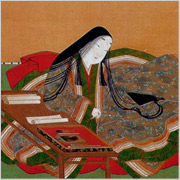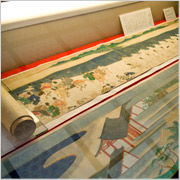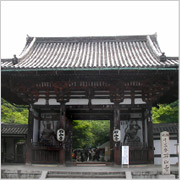
The Tale of Genji
The Tale of Genji

In the first year of Kanko era(1004) in Heian period, Lady Murasaki Shikibu, staying at The Ishiyama Temple, prayed to Kannon Bosatsu (avalokitesvara; the Goddess of Mercy) for the successful creation of a new full novel, the title of which came to be known later as “The Tale of Genji”. The daughter of Emperor Murakami, namely Senshi princess wanted to read a completely new novel not yet read by her and asked one to the wife of Ichijyo-in, namely Syoto-mon’in, but the latter did not have it at her hand. So she asked Murasaki Shikibu, a court lady in the service of Syoto-mon’in to write a completely new novel for Senshi princess. The night happened to be the night of August 15th, and in the heart of Murasaki Shikibu who was watching the harvest moon reflected on the water of Lake Biwa, an idea of one novel has begun to float. Using the reverse side of Dai Han’nyakyo (The great prajna-paramita-sutra) book just at her side, she began to write “Koyohi ha jyugoya narikeri to oboshiidete, denjyo no onasobi kohishiku” (Tonight being the night of the 15th of the month, i.e. a harvest moon night, it reminds nostalgically me of a concert held at the Imperial Court). She began to write the scene that at a distant place from Kyoto or Miyako a high ranking nobleman is reminded of Miyako. In this way, The Tale of Genji was started. This part was later used in the Tale of Genji on a scene in the Suma Chapter in which Hikaru Genji, or “The shining Genji” withdrawing to Suma is reminded of the orchestral concert held at the Imperial Court, consisting of wind and string instruments under the harvest moon on the 15th of the month.
This legend concerning the very beginning of The Tale of Genji mentioned in various books such as “Ishiyama Temple Engi Emaki (the picture scroll of the legend of The Ishiyama Temple)” , “Kakaisyou( the old annotation book of The Tale of Genji)”, et cetera, is familiarly well known among people from the very old days. The room in which Murasaki Shikibu stayed for offering prayers to Kannon at The Temple is even today kept as The room of Genji, together with Suzuri (an ink stone) which had been said to be used by herself. People attracted by this legend brought together pictures or poetry pieces related to The Tale of Genji or Murasaki Shikibu to The Temple and many of these have played the role to remind people of the old Heian period until today.

Some of these pieces are, for example, the famous “Ishiyama Temple Engi Emaki (the picture scroll of the legend of The Ishiyama Temple )” which is one of the important cultural properties of Japan, “The Tale of Genji Engi Emaki, Suetsumuhana (the picture scroll of the legend of the chapter of Suetsumuhana, The Tale of Genji )” written by Tosa Mitsuoki, many pictures of Murasaki Shikibu deeply pondering upon the novel plan made at various periods, the beautiful full set of The Tale of Genji donated by Daimyo Rakuo Matsudaira Sadanobu of The Shirakawa clan, “The Yoriaigaki Tale of Genji” ( another kind of The Tale of Genji done by many participants who are aristocrats and court noblemen in early Tokugawa Period and contributed in writing each one chapter of The Tale of Genji per person, and also great many Waka poems, Renga poems, Haiku poems, travel descriptions which men of letters associated with The Tale of Genji had contributed. This shows that a truly lot of people are all the time until today being attracted by The Ishiyama Temple and Murasaki Shikibu.
Another one of important characteristics of The Ishiyama Temple is that the Temple have accumulated many donated “Genjie(the pictures of The tale of Genji describing each famous scene in the Tale)”. The famous scenes which readers of The Tale of Genji are always reminded of later are being visualized as forms of pictures by famous artists at each period. Thus readers can enjoy The Tale not only by reading but also by looking at pictures attached to The Tale. Hikaru Genji, or ”The shining Genji”, Yuhugao, Murasakino-ue, Rokujyo-miyasudokoro, Ukihune, etc. i.e. major characters in The Tale are drawn vividly in the picture forms.

Also there are not few Waka poems and Renga poems associated with The Tale of Genji. Some are very unique indeed. Genjimonogatari- makimaki-no-waka or “Waka poems of The Tale of Genji” was dedicated to The Temple by Kitamura Kigin in the first year of Houei era(1704) in Edo period. He is well known as the author of “The Tale of Genji, Kogetsusyo”. Another unique Waka poem series are “ The Tale of Genji, Kanmuri Waka,(Crown style Waka poems)” made by Kamono Suketame, a Shinto priest of the Kamo Shrine and dedicated to The Temple in the second year of An’ei period(1773). “Kanmuri Waka” is a special kind of Waka poems which utilize the full characteristics of Japanese hiragana characters. He used the famous “Koyohi ha jihugoya narikeri …”, or “Tonight is the harvest moon night of 15th day of the month… ” for this Waka. Suketame took each one of the Japanese hiragana characters from the above poem line by this order and used this character at the first half line head and latter half line head at the newly made Waka poems, creating total of 100 poems.
Thus The Ishiyama Temple has attracted the truly profound interest from great many people as the environment which came to produce The Tale of Genji. It is probably because Kannon (avalokitesvara; the Goddess of Mercy) faith of The Ishiyama Temple and The Tale of Genji are inseparably connected each other. People visiting The Ishiyama Temple and offering a prayer to Kannon must at the same time have had a deep attachment to Murasaki Shikibu who came here a long long time ago and wrote The Tale of Genji. It may be said in this connection that in the medieval age the graceful figure of Murasaki Shikibu meditating on The Tale of Genji and Kannon are overlapped each other in one Kannon figure. Actually the picture incorporating this concept existed at this age and this explains there was definitely the faith that Kannon and Murasaki Shikibu must be one and the same.
〒520-0806 大津市打出浜2-1 コラボしが21 9階
TEL:077-511-1500/FAX:077-526-0795





